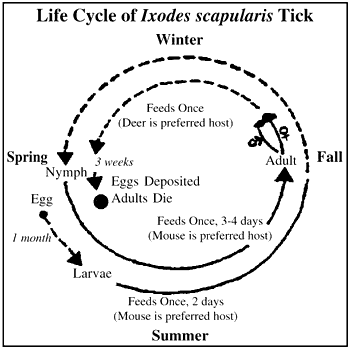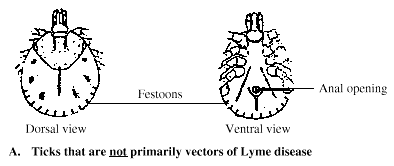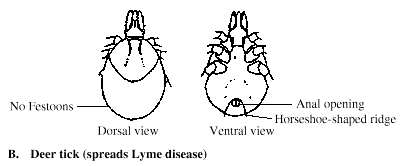
Deborah
Smith-Fiola
Rutgers Cooperative Extension

Lyme
disease is caused by a bacterium transmitted by the deer tick,
Ixodes scapularis (now known as the black-legged tick). The
deer tick is found in high grassy areas, open fields, and
in woods with a shrubby understory.
Ticks
live in the shrubby understory of the forest. Ticks do not
jump or fly--they wait on vegetation for an animal to brush
against them. They then attach to the animal and insert their
mouth parts (without burrowing beneath the skin). Following
a blood meal, the tick swells to twice its normal size, and
drops to the ground.
After
hatching from an egg in late spring, the deer tick goes through
three life stages: larva, nymph, and adult. Each stage requires
a different host animal and feeds only once. Deer ticks take
two years to complete their life cycle.
 |
Larvae - are very small (about the size of a pin head)
and tan. They feed in late summer, near ground level,
on mice, shrews, chipmunks, voles, and other small animals.
Larvae can pick up the disease from an infected animal.
Peak activity: August. |
 |
Nymphs - are the size of a poppy seed. They are biege,
sometimes appearing transparent with a dark head. Nymphs
feed from May through August on larger animals; including
birds, racoons, opossum, squirrels, cats, dogs--and human
beings. Peak activity: late May-June. |
 |
Adults - are the size of a sesame seed. Males are black;
females have a brick-red abdomen and a black shield near
the head. Females swell to 1/4 inch when fully engorged
after feeding. Adults are active all winter long, as long
as temperatures are above freezing. Adults feed primarily
on deer, but will also attack cattle, horses, dogs, etc.
Human beings are accidental hosts. Peak activity: October/November.
|
All
ticks go through three growth stages (larva, nymph, adult)
which differ in size. All stages have distinctive features
that separate tick species. The following drawings are greatly
enlarged to show characteristics used for identification of
hard ticks:
Festoons--ridges
on the edge of the lower abdomen. Deer ticks do not have festoons.
Other common ticks do have festoons.
Anal
Opening--looks like a navel on the ventral side of a tick.
It tends to be in the center of the body of most ticks. On
the deer tick, the anal opening is near the lower edge of
the abdomen AND is surrounded by a horseshoe-shaped ridge.


 The risk of being bitten by an infected deer tick is greatest
in the summer months, especially in May and June, when the
nymph stage is active. This is the time of year when people,
notably children, are most active outdoors. Make a habit of
thoroughly checking yourself and others for the tiny nymph
after outdoor activities and vacations.
The risk of being bitten by an infected deer tick is greatest
in the summer months, especially in May and June, when the
nymph stage is active. This is the time of year when people,
notably children, are most active outdoors. Make a habit of
thoroughly checking yourself and others for the tiny nymph
after outdoor activities and vacations.
About
25 to 50 percent of the deer ticks in New Jersey (depending
on where they are found) are infected with and able to transmit
Lyme disease. Newly hatched deer ticks do not initially carry
this disease; they pick it up from an infected animal. The
white-footed mouse is the primary carrier of the Lyme disease
bacterium. Once a tick picks up the bacterium, it will retain
it to its next stage, and be able to infect future host animals.
Research
indicates that a tick must feed for at least 24 hours to transmit
the disease bacterium.
- Headache
- Flu like
symptoms
- "Bull'seye"
rash (> 2" in diameter)
- Swelling
and pain in the joints
Lyme
disease symptoms mimic many other diseases. About 70 percent
of Lyme disease victims will develop a rash within two days
to four weeks. If untreated, more severe symptoms may develop--sometimes
months to years later.
If you
suspect Lyme disease, consult a physician immediately. Symptoms
that progress very quickly could be the result of Ehrlichiosis
(H.G.E.), another tick-borne disease.
If you
find a tick on your body, remove it AS SOON AS POSSIBLE. Use
tweezers ONLY. Bent "needle nose" tweezers work best. Do NOT
use nail polish, vaseline, matches, or other methods (the
latter procedures may traumatize the tick and cause it to
regurgitate its gut contents). Grasp the tick with tweezers
around its head, close to the skin. Pull it up and out slowly
and firmly. Disinfect the bite afterward with antiseptic.
Save
the live tick for identification by the RUTGERS COOPERATIVE
EXTENSION office in your county.
- Avoiding
ticks outdoors
- Avoid
tall grass and shrubby areas.
- Wear
long pants tucked into socks.
- Wear
light-colored clothing (to help locate ticks easily).
- Stay
close to the center of hiking trails (avoid brushing
against vegetation).
- Thin
out low shrub vegetation in woods.
- Keep
turfgrass mowed.
- Remove
brush piles (it serves as animal nesting sites).
- Use
a repellent
- Apply
to shoes, socks, and pants, and allow to dry:
- PERMETHRIN
(Permanone, Duranon)-- kills ticks on contact--labeled
for clothing only, it will last through two or three
washings.
- N,N-Diethyl-meta-toluamide,
commonly known as DEET ("Off," "Cutter," "Muskol,"
etc.) --repels ticks; labeled for skin or clothing.
CAUTION: Certain people are sensitive to formulations
of DEET that contain more than 50% active ingredient.
- Pesticide
Control
- "DAMMINIX"
is a product that provides insecticide- laced nesting
material to mice. It kills immature ticks attached to
mice in their burrows.
- If
ticks are present, treat edge areas where turfgrass
and the woods meet, and 12 feet into the woods to create
a protective barrier.
- Insecticides
applied periodically can help to reduce tick populations.
READ AND FOLLOW ALL PRECAUTIONS AND DIRECTIONS ON THE
INSECTICIDE LABEL. Some insecticides labeled for tick
control include: DURSBAN (chlorpyrifos), DIAZINON (spectracide),
SEVIN (carbaryl), and TEMPO (cyfluthrin)*
- (a)
GRANULAR insecticides provide superior control of immature
ticks. One application the last week of May provides season-long
control. Research shows 90 to 95% control of nymphs with
one properly applied treatment at this time.
- (b)
LIQUID insecticides provide good control of adult ticks.
Apply in November and/or March. Spray vegetation to runoff.
* This
insecticide is for use only by professional applicators.
For
more information, contact: Rutgers Cooperative Extension office
in your county or your local health department.
- Atlantic
6260 Old Harding Highway, Mays Landing, NJ 08330-1533 609-625-0056
- Bergen
327 Ridgewood Avenue, Paramus, NJ 07652-4896 201-599-6162
- Burlington
Office: 122 High Street 609-265-5050
Mail: 49 Rancocas Road, Mt. Holly, NJ 08060-1317
- Camden
152 Ohio Avenue, Clementon, NJ 08821-4184 609-784-1001
- Cape
May 4 Moore Road, Cape May Court House, NJ 08210-1601 609-465-5115
- Cumberland
Extension Education Center, 291 Morton Avenue, Millville,
NJ 08332-9776 609-451-2800
- Essex
115 Clifton Avenue, Newark, NJ 07104 973-481-5302 *
- Gloucester
County Building, Delsea Drive, Clayton NJ 08312-1095 609-863-0110
- Hunterdon
4 Gauntt Place (off Route 31), Flemington, NJ 08822-9058
908-788-1339
- Mercer
930 Spruce Street, Trenton, NJ 08648-4584 609-989-6830
- Middlesex
390 George Street (8th Floor), New Brunswick, NJ 08901-2018
732-745-3446
- Monmouth
20 Court Street, Freehold, NJ 07728-1702 732-431-7260
- Morris
Office: Building 550, West Hanover Avenue, Morris Township
973-285-8300 *
Mail: P.O. Box 900, Morristown, NJ 07963-0900
- Ocean
Extension Center, 1623 Whitesville Road, Toms River, NJ
08755-1199 732-349-1246
- Passaic
1310 Route 23 North, Wayne, NJ 07470 973-305-5742 *
- Salem
51 Cherry Road, Suite 1, Woodstown NJ 08098-9982 609-769-0090
- Somerset
310 Milltown Road, Bridgewater, NJ 08807-3587 908-526-6644
- Sussex
3 High Street, First Floor, Newton NJ 07860-9115 973-579-0985
*
- Union
300 North Avenue East, Westfield, NJ 07090-1499 908-654-9854
- Warren
Admin. Bldg., 165 County Rd., Route 519S, Belvidere, NJ
07823-1949 908-475-6505
*
Effective June 28, 1997. Prior to this date, use the 201 area
code.
- New
Jersey Department of Health: 800-792-8831
- Jersey
Shore Medical Center - Lyme Resource Center: 201-776-4455
- National
Lyme Borreliosis Foundation - Connecticut: 203-871-2900
- Lyme
Disease Foundation: 800-886-LYME
- Lyme
Disease Network Newsletter: 908-390-5027

Disclaimer
and Reproduction Information: Information in NASD does not represent
NIOSH policy. Information included in NASD appears by permission
of the author and/or copyright holder. More
NASD Review: 04/2002
Deborah
Smith-Fiola - County Agricultural Agent, Ocean County
This
publication was made possible in part by a grant from the
National Institute for Occupational Safety and Health Program
on Agricultural Health Promotion Systems for New Jersey.
|
